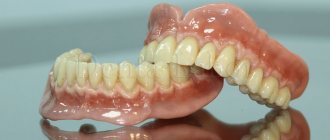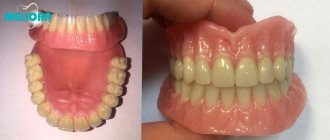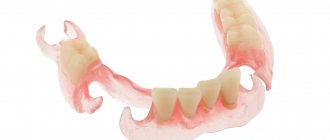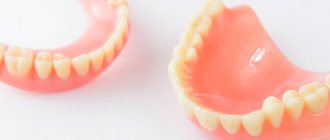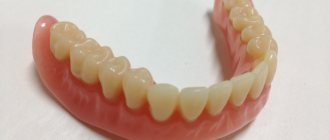A clasp denture is an ideal solution for restoring a number of teeth in the lower jaw, when the patient has retained several of his dental units, but it is not possible to install a full-fledged bridge on them for objective reasons. Also, this design is ideal if the patient does not want (or cannot) install implants, but wants to restore his smile and achieve optimal results for a reasonable budget. Yes, the clasp prosthesis for the lower jaw is a removable model, but it copes with the task perfectly, is a worthy alternative to outdated plate models, and the service life of such a solution is from 10 years.
Removable clasp prosthesis for the lower jaw - consider in detail
Why is a denture for teeth called clasp? The name itself comes from the word “arc”. It is based on a thin cast arc-shaped metal element, onto which a plastic base imitating gum is fixed, as well as artificial crowns - smooth and beautiful teeth. Thanks to the arch, the teeth replacement system is highly durable and reliable, because it will have to be removed and put on at least once a day. As a result, the patient receives a compact, lightweight, comfortable prosthesis for the lower jaw, which is easy to get used to in the first few hours after installation.
How is the prosthesis fixed on the supporting, pre-prepared teeth of the lower jaw? Using hooks or special elements. They are placed on top of the patient’s teeth or on pre-implanted implants. By the way, the prosthesis locks themselves are made not only of a metal alloy, but also of plastic, which is especially important for people with an allergic reaction to metal. But the gums can be made of either nylon or plastic bases (acri-free, quadrotti solutions). When it comes to dental crowns, they are usually made from a plastic material that imitates enamel.
It is important! The specificity of the prosthesis for the lower jaw presupposes that the arch is located on the side of the tongue, that is, where it is not visualized at all. The distance from the arch to the cervical area of the teeth is approximately one millimeter, and a little more is the distance to the bottom of the mouth.
Varieties
Clasp dentures have different fixations on the remaining teeth. They can be on clasps, on locks and on telescopic crowns. Various prosthetic fixation systems have both advantages and disadvantages, and at the moment we will tell you about both.
Clasp dentures with clasps
This design is fixed using hook-clasps, which very tightly clasp the abutment tooth. Clasps are made of metal. With their help, the denture is firmly held on the jaw and, when chewing, transfers the load to the teeth. In most cases, clasps are cast together with the frame, so this design is highly strong and durable. Clasps are selected individually in accordance with the size and shape of the teeth.
Clasp dentures with locks also have differences in cost: One-sided clasp dentures are used in the case of a one-sided lack of dentition, with contraindications for dental implantation, in the absence of the ability to produce a fixed bridge prosthesis, and in some other cases. Most professionals and professionals in the field of dentistry believe that that at present there is no candidate for clasp dental prosthetics. Now clasp dentures are managed at the appropriate level with their main tasks - the restoration of lost chewing functions and the creation of the cosmetic effect of healthy teeth.
Clasp dentures with locks
Clasp dentures with locks have a strong, lightweight bridge-like structure, which, when chewing, transfers some of the pressure to the supporting teeth. To protect and strengthen the abutment teeth, they are previously covered with metal-ceramic crowns, into which half of the lock is inserted, and the other half is placed on the abutment teeth. When installing the prosthesis, the lock snaps into place.
Locks fixed in the teeth or in the crowns of the teeth provide the highest strength of the prosthesis. In addition, they allow you to firmly fix the structure and simply remove it for repeated cleaning.
They have clasp dentures with locks and several shortcomings. One of them is the complexity of production. Currently, in dental prosthetics, this is the most high-tech design, the production of which requires the highest qualifications of a dental technician and an orthopedic doctor. In the manufacture of such a prosthesis, the highest accuracy of calculation of all parts of the structure is essential. This leads to the second drawback - the highest price. Their effectiveness in comparison with other types of prosthetics is expressed in the comfort of wearing such a denture and comfortable eating. In addition, they are reliable and have a long service life. The cast iron frame is the main difference between the clasp type of prosthesis and the plastic one. Artificial teeth and a plastic base are fixed to this frame.
Caring for a clasp denture
Also, in each individual case, the cost of a clasp denture will depend on the type of fixation of the prosthesis to the teeth. Clasp prosthetics with locks are an order of magnitude more expensive, because in this case the total price also includes the cost of locks and metal-ceramic crowns. Clasp dentures have a different price range: It is very comfortable, convenient and comfortable from the mental side. All you need to do is remove the prosthesis often and do ordinary hygiene procedures. Take care of your own clasp denture, then you will never complain about the appearance of stomatitis, changes in speech and discomfort when chewing.
Price of clasp prosthetics
Nowadays, one of the most popular types of dental prosthetics is clasp prosthetics, the price of which depends on different clinical situations. There are ordinary and complex clasp dentures. Complex clasps have a system of clasps; they may have not one, but two iron arcs.
The next difference is the cost. The cost of installing clasp dentures is determined by many reasons. Before creating and installing a partial denture, the dentist prepares the oral cavity: cures the teeth, removes plaque, replaces the supporting teeth with crowns and takes impressions of the teeth. These works should be taken into account; otherwise, the expected cost of prosthetics may actually turn out to be significantly higher.
The clasp denture completely complements the dentition. But artificial teeth, just like natural teeth, require careful care. Caring for a clasp denture is not difficult; you don’t even have to take it off at night.
- conventional clasp prosthesis – from fifteen thousand rubles.
- complex clasp prosthesis – from 20 thousand rubles.
- clasp splinting prosthesis – from 20 thousand rubles.
Thus, clasp dentures with clasps are a good option for dental prosthetics, which has only one drawback - low aesthetics. When you grin, iron hooks may be visible in your mouth. But this applies only to individual cases when installing a prosthesis using another method is simply clinically impossible. It should be noted that the price of this type of prosthesis is higher compared to its plastic counterparts.
- regular clasp prosthesis – from 50 thousand rubles. (with all this, the price already includes the cost of the prosthesis, locks and 4 crowns);
- one-sided clasp prosthesis – from 30 to 5 thousand rubles. (with all this, the price already includes the cost of the prosthesis, 2 crowns and locks).
Indications for prosthetics
Clasp dentures are installed on the lower jaw if:
- there is an extensive defect - for example, more than two teeth in a row are missing;
- all teeth are completely missing - in this case, to fix the prosthesis, the patient is first implanted with supporting implants;
- the last teeth in the row are missing;
- The patient has chronic periodontitis and there is a need to additionally strengthen the remaining teeth in the row with the help of a prosthesis.
In the meantime, prosthetics with clasp artificial structures are not recommended when:
- there are less than four teeth left in the jaw - unfortunately, this is not enough for a high-quality support base;
- the patient suffers from acute chronic illnesses;
- bone problems have been diagnosed (for example, osteomyelitis of the jaw, as well as osteoporosis);
- a person has an inflamed oral mucosa.
Clasp dentures - what is it?
In some cases, even professional treatment cannot help restore teeth, especially in advanced and complex cases. Quite often the patient seeks help very late.
Naturally, you can use other methods of prosthetics. For example, make classic plastic dentures or removable nylon dentures. But when choosing the right option for yourself, think about how comfortable you will feel and how long the denture will last for you.
And the third drawback is the role in the design of a huge number of teeth. This type of clasp prosthesis implies the constant protection of the supporting teeth with metal-ceramic crowns, since locking fasteners are placed on them. Clasp dentures with locks.
The process of getting used to the clasp prosthesis - features and nuances
The process of getting used to a clasp denture installed on the lower jaw is not at all quick. At first, the patient may be bothered by excessive salivation and discomfort while chewing food. There may also be speech defects - it is difficult for a person to pronounce hissing and whistling sounds. Also, at first you may feel a slight rubbing of the oral mucosa, but this is normal.
If discomfort when wearing dentures bothers you for more than a week, you need to visit a dentist. The system may need to be adjusted slightly to resolve the discomfort.
Caring for telescopic dentures
- Such prostheses do not require daily removal
(as happens with other types of removable dentures, for example, dentures)
- Recommended come for preventive examinations
dentist to identify problems at an early stage
- A telescopic prosthesis can last up to 10 years
with careful handling
- Telescopic prosthesis can be brush like regular teeth
, but it is advisable to sometimes remove it in front of a mirror over a soft surface and gently wash it with a brush
In the NovaDent dental network in Moscow and the Moscow region, you can install telescopic dentures absolutely painlessly and at a budget price, with the preparation of an accurate treatment plan and an individual schedule of visits.
Sign up for a free consultation with a specialist who will conduct a diagnosis and help you choose the right prosthesis.
How much does a clasp prosthesis cost?
The price of lower jaw prosthetics using a clasp design depends on the following factors:
- base and frame material;
- the number of teeth that need to be restored with a prosthesis;
- material for dental crowns.
The average price of a clasp prosthesis is from 32,000 rubles. The price, as a rule, already includes payment for the prosthesis itself, treatment planning, installation of the system, and check-ups with the dentist.
Clasp dentures are an inexpensive and accessible way to restore a smile with a long service life (more than 10 years).
Design Features
Telescopic dentures are a subtype of clasp dentures. This is a single removable structure with a base that looks like natural gum, a special metal arch (clasp) and artificial teeth on it.
Photos of telescopic crowns:
The prosthesis is called “telescopic” because of its special structure and fixation system - it consists of two parts that are inserted into one another, like in a telescope.
1 part
-
a non-removable base
in the form of a metal cap, which is fixed to the remaining part of the tooth and serves as a support for the visible part
part 2
—
external structure
in the form of a crown imitating a real tooth, an artificial gum flap and a clasp attachment
Pros and cons of splinting clasp devices
In order for the prosthetic system to solve all the assigned dental problems, it is selected taking into account the condition of the remaining units, the degree of their loosening, location features, and the quality of the periodontium as a whole. If a clasp-type splinting prosthesis is selected and installed correctly, it ensures the most even distribution of the chewing load on the remaining abutment teeth.
Its other advantages include:
- compact size, making it easier for the patient to get used to the presence of a foreign body in the mouth;
- the absence of an artificial palate that spoils diction;
- sufficient strength and durability;
- creating conditions in the oral cavity that make it possible to inhibit further atrophy of bone tissue.
Among the disadvantages of clasp splinting devices:
- Lack of aesthetics. That is why young people rarely resort to their help.
- Gradual weakening of the splinting effect.
- Risk of injury to the mucous membranes of the oral cavity with metal clasps when putting on the device.
What problems may arise after installing a denture?
Adaptation to a removable denture begins almost immediately after installation is completed in the dentist's office. And, according to statistics, almost every patient experiences certain difficulties that are associated with the adaptation period. Here are some of them:
- Vomiting reflex . Constant vomiting is a completely normal reaction of the body to a foreign object in the oral cavity, so there is no need to worry too much about this. But there is a category of people who take the longest to get used to dentures, or who don’t get used to them at all. The installation of products that stick to the sky is contraindicated for them. This must be taken into account when choosing a prosthetic method. Often, this problem goes away on its own. But for patients with hypersensitivity, it is better to abandon such structures altogether.
- Profuse salivation . The human body perceives the prosthesis as food, as a result of which the brain sends signals that then activate the corresponding functions, namely the secretion of saliva and gastric juice.
- Unpleasant sensations while eating . First of all, this problem affects the owners of removable dentures; the load is unevenly distributed across the jaw, in contrast to the natural chewing of food with real teeth. It takes a long time to get used to this.
- Perception of taste . You may partially lose your sense of taste, since not only the tongue (as many believe), but also the rest of the oral cavity is involved in its perception. The patient may stop feeling spicy, salty, hot or sweet foods; this process occurs differently for everyone.
- Distortion of speech . The prosthesis and its protruding parts can interfere with the tongue; a person with an installed prosthesis has difficulty pronouncing words. But after some time (about a week), diction returns to normal.
Prices for orthopedic structures
| Orthopedics | price, rub. |
| Metal-ceramic structures | |
| Metal-ceramic crown | 8500 7500 |
| Solid anatomical crown | 4800 |
| Solid anatomical crown with coating | 5800 |
| Solid-cast thin-walled crown (stamped crown tax) | 3800 |
| Artificial ceramic gums (1 unit) | 2400 |
| Splinting of metal structures (from 8 units) | 12000 |
| Metal-free structures, veneers, inlays | 17200 |
| Zirconium dioxide crown | from 14000 |
| All-zirconium anatomical crown | 13200 |
| Telescopic crown | 6400 |
| Plastic crown (permanent) | 3200 |
| Provisional crown (temporary) | 1200 |
| Artificial ceramic gums on zirconium dioxide (1 unit) | 3400 |
| Splinting with zirconium dioxide (from 8 units) | 20000 |
| IPS e.max crown / veneer / inlay with ceramic veneer | 18800-22000 |
| IPS e.max crown / veneer / inlay with staining | 15600 |
| Implant-supported structures | |
| Metal-ceramic crown supported by an implant | 15000 |
| Solid anatomical crown supported by an implant | 9600 |
| Implant-supported zirconium dioxide crown | 24000 |
| All-zirconium crown supported by an implant | 20000 |
| Metal-ceramic crown with implant support, screw fixation (CAD-CAM) | 21000 |
| Metal-ceramic intermediate tooth with implant support (any fixation) | 12000 |
| Intermediate tooth on zirconium dioxide supported by an implant (any fixation) | 18000 |
| Temporary crown supported by an implant | 2000 |
| Individual titanium abutment made of Pre-milled | 16000 |
| Individual zirconium abutment | 16000 |
| Laboratory abutment | from 6000 to 36000 |
| Abutment key (1 segment) | 2000 |
| Transfer check (1 segment) | 2800 |
| Bonding of crown/abutment (1 unit) | 2000 |
| Removable structures (incl.: prosthesis, consumables, doctor’s work) | |
| Cosmetic prosthesis (up to 3 teeth) | from 5600 |
| Partially removable denture (classic) | from 15500 13500 |
| Complete removable denture (classic) | 17500 15000 |
| Cosmetic prosthesis “Acry-Free” (up to 3 teeth in one segment) | 12000 |
| Partially removable denture "Acry-Free" | from 21000 from 19500 |
| Complete removable denture "Acry-Free" | from 23000 from 22000 |
| Removable screw-fixed prosthesis supported on implants (temporary structure, without components) | from 58000 |
| Removable denture on locators (ball-shaped locks, without components) | from 58000 |
| Reinforcement of a removable denture (standard) | from 3000 |
| Reinforcement of a removable denture (casting) | 4000 |
| Reinforcement of a removable denture (individual) | 8800 |
| Reinforcement of a removable denture (quartz mesh) | 14000 |
| Removable denture on 4 implants | 130000 110000 |
| Removable denture on 6 implants | 180000 160000 |
| Clasp designs | |
| Clasp prosthesis with clasp fixation | from 42000 |
| Clasp prosthesis with locking fixation | from 66000 |
| Clasp denture on telescopic crowns (at least 2 supports) | from 30000 from 28000 |
| Clasp prosthesis made of thermoplastic Acetal | from 30000 |
| Additional support in the locking clasp | from 12000 |
| Additional support in the clasp on telescopes | from 14000 |
| Cleaning and polishing the clasp denture | 6000 |
| Additional types of work | |
| Auxiliary model | 1200 |
| Diagnostic model | from 1500 |
| Collapsible model | 2800 |
| Fixation of the crown | 1000 |
| Wax modeling (1 unit) | 1600 |
| Wax template | 1400 |
| Individual spoon | 2400 |
| Laboratory pin insert | 3200 |
| Additional pin for laboratory pin placement | 1200 |
| Application of opaque | 800 |
| Sputtering | 1200 |
| Casting (clinical) | 800 |
| Gum mask (1 unit) | 1600 |
| Taking one impression A silicone (1 jaw) | 1000 |
| Taking one impression with silicone (1 jaw) | 600 |
| Repairing and cleaning dentures | |
| Relining the Acrylic prosthesis | 4000 |
| Relining the Acry-Free prosthesis | from 8000 |
| Repairing a prosthesis | from 3200 |
| Repairing a clasp denture | from 8000 |
| Tooth welding (1 unit) | from 2400 |
| Welding the clasp (1 unit) | from 2800 |
| Cleaning and polishing the denture | 3200 |
| Cleaning and polishing the clasp denture | 8000 |
| Repairing, cleaning and polishing of the prosthesis (complex) | from 5200 |
| Mouth guards | |
| Mouth guard night/retention | 5600 |
| Whitening tray | 6800 |
| Sports mouthguard 3-layer | 18000 |
Contraindications
The use of clasp splinting devices is contraindicated:
with unsatisfactory oral hygiene;- during pregnancy;
- for acute inflammatory lesions of the mucous membranes and gums;
- in the period after radiation therapy sessions;
- for oncology;
- for mental illness;
- for severe heart pathologies;
- with pronounced disturbances in the structure of bone tissue;
- with individual intolerance to metal;
- if the supporting teeth do not have the required height;
- in case of unsatisfactory condition of support units.
The doctor makes a decision on the possibility of prosthetics using a splinting clasp device after an in-person examination of the patient’s oral cavity and a series of diagnostic techniques.
